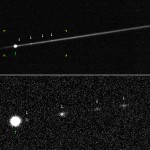W. M Keck Observatory press release…
A team led by astronomers from the Jagiellonian University in Krakow, Poland, recently used the W. M. Keck Observatory in Hawaii to observe and measure a rare class of “active asteroids” that spontaneously emit dust and have been confounding scientists for years. The team was able to measure the rotational speed of one of these objects, suggesting the asteroid spun so fast it burst, ejecting dust and newly discovered fragments in a trail behind it. The findings are being published in Astrophysical Journal Letters on March 20, 2015.

Then in 2010 a new type of active asteroid was discovered, which ejected dust like a shot without an obvious reason. Scientist gravitated around two possible hypotheses. One states the explosion is a result of a hypervelocity collision with another minor object. The second popular explanation describes it as a consequence of “rotational disruption”, a process of launching dust and fragments by spinning so fast, the large centrifugal forces produced exceed the object’s own gravity, causing it to break apart. Rotational disruption is the expected final state of what is called the YORP effect – a slow evolution of the rotation rate due to asymmetric emission of heat.
Continue reading “Unusual Asteroid Suspected of Spinning to Explosion”
